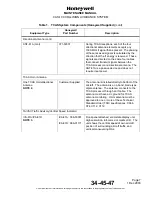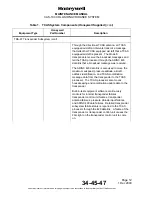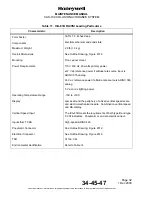
Page 19
1 Dec 2003
34-45-4
7
MAINTENANCE MANUAL
CAS-100 COLLISION AVOIDANCE SYSTEM
Use or disclosure of information on this page is subject to the restrictions in the proprietary notice of this document.
B. TPA-100A TCAS Processor
Table
5 lists the available configurations of the TCAS processor and the related features.
Table
6 contains or references a short description of the processor features that are not
self-explanatory.
Table 5. TPA-100A TCAS Processor, Available Configurations
Table 6. TPA-100A TCAS Processor Features
3. System Leading Particulars
A. TCAS Surveillance Volumes
Surveillance volume is that volume of airspace for other aircraft with Mode S or ATCRBS
transponders that are tracked by own aircraft TCAS.
(1) Range Tracking Volumes
The shape and size of the range tracking volume depends on:
• If Mode S or ATCRBS transponders are being interrogated
• If tracking is occurring on a directional or OMNI antenna
• The attenuation levels applied to the transmitted pulses from the TCAS processor's
transmitter.
NOTE:
The TCAS processor decreases range tracking volumes in high density
areas to
decrease the number of receptions to be processed by TCAS and for
interference limiting.
Part
Numbers
940-0300
and
940-0400
Features
Basic
Unit
-001
X
Feature
Description
Basic Unit
Supplies primary function and control for CAS-100.
Long range active surveillance.
Passive (ADS-B) only surveillance.
DTIF (Strap selectable).
ARINC 615-3 DL.
PCMCIA.
Front panel LCD maintenance interface.
4 or 6 MCU.
















































